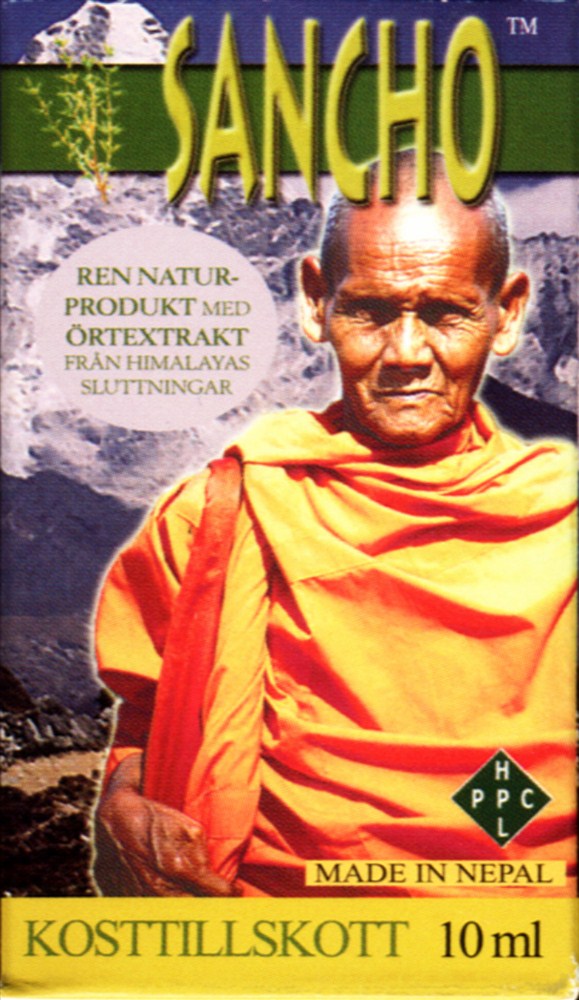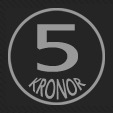Hur använder man Sancho
Rekommenderad användning – invärtes bruk:
Vuxna: 6 droppar 3 ggr dagligen när behov uppstår.
Barn från 8 år: 3 droppar 3 ggr dagligen när behov uppstår.
Sancho droppas i en kopp med varmt vatten och drickes. Du ska kunna dricka vattnet innan du tillsätter dropparna. Innehållet räcker till 50 tillfällen.
Utvärtes användning: Massera/applicera på det drabbade området 2-3 ggr dagligen så länge behovet finns.
Sancho är en unik blandning av eteriska oljor från Himalaya som traditionellt använts av lokalbefolkningen.
Vid Himalayas sluttningar används denna blandning också för fräsch andedräkt samt för att stöta bort mygg & knott. Sancho är en ren och högkvalitativ naturprodukt som framställs av de bästa råvarorna.
Deklaration/ingredienser per dags dos 0,6 ml/ 18 droppar
Åkermynta olja Mentha arvensis 216 mg
Eukalyptus olja Eucalyptus 113 mg
macrorrhyncha
Kamfer olja Cinnamomum 81 mg
camphora
Citrongräs olja. Cymbopogan 19 mg
flexus
Vintergröna olja Gaultheria 11 mg
fragrantissima
Kanelblads olja. Cinamomum 8 mg
tamala
Nepalesisk peppar olja Zanthoxylum alatum 5 mg
Bas Flytande paraffin q.s.
Observera:
Produkten bör inte användas av gravida, ammande och barn under 8 år.
Kosttillskott bör inte användas som ett alternativ till en varierad kost. Överskrid ej det angivna rekommenderade dagliga intaget. Förvaring: Torrt och i rumstemperatur och utom räckhåll för barn.
Producent: HPPCL, Katmandu, Nepal
Marknadsföres av Lifeport, Erikslustvägen 36 G, 217 73 Malmö www.lifeport.se, Konsumentkontakt: 0290-76 76 80
Tillfällen när man kan använda Sancho?
Insektsbett: Massera in en droppe på bettet så slutar det att klia. Fungerar även mot "bedbugs"och dylikt när du är utomlands.
I förebyggande syfte mot insektsbett: Stryk på Sancho på de ställen där du normalt använder myggmedel. Vi har även fått rapporter på att djurägare har preparerat sina hästar och andra husdjur sommartid med Sancho för att hålla mygg och knott borta.
Resor: Om du ska ut och resa, speciellt om du ska flyga långt, kan det vara bra att ha Sancho med sig och dricka en kopp när kaffe och te serveras.
Stress: Smörj Sancho i t ex nacken och tinningarna och känn den avslappnade doften av Eukalyptus och camfer.
Om du känner dig frusen & trötter: Drick någon värmande kopp med Sancho
Nästäppa/bihålor: Ta en droppe Sancho på ditt lillfinger och för upp det i näsborrarna.
Vid muskelspänningar kring nacke/huvudet eller andra muskler: Stryk Sancho bakom öronen, på tinningarna eller muskelområdet som det berör.
Ömma och stela muskler: Applicera Sancho på det ömma området genom att massera in det. Går du på massage – lämna fram din flaska Sancho och låt massören droppa några droppar på din hud och massera in innan han/hon använder sin vanliga massageolja – det kommer att kännas otroligt skönt!
Ömma och trötta fötter: Om man till exempel har ett jobb där man går och står mycket så kan man ofta bli öm och trött i fötterna. Hjälp dina att fötter att återhämta sig genom att på kvällen när du kommer hem tvätta av dina fötter och sedan smörja in dem med Sancho, liksom du smörjer in dina händer med handlotion. Det blir otroligt upplyftande och revitaliserade för dina fötter och de kommer vara dig evigt tacksamma!
För bättre andedräkt: Ta några droppar i munnen och på tungan och fördela runt i munnen, alternativt ta några droppar i vatten och gurgla.
Snarkning: Ta en droppe Sancho på lillfingret och för upp i båda näsborrarna innan sänggående. Om du har andningsvägarna genom näsan fria så brukar snarkningarna avta och du får en bättre sömn!
Koncentration och meditation/yoga: Ta en droppe Sancho på lillfingret och för upp i båda näsborrarna innan eller under din aktivitet för att återfå fokus och koncentration. Fungerar även bra när du till exempel pluggar eller kör bil och behöver hålla dig vaken och alert.
Bastu/svetthydda: Droppa några droppar Sancho på aggregatet, eller i vattnet som sedan hälls på aggregatet.
Överkänslighet mot nässprayer? Prova att ersätta din nässpray med Sancho
Vilka örter finns i Sancho?
Du kan alltid ”googla” örterna som finns i Sancho och få en känsla för hur de används inom olika områden.
Nedan finner du en kortare beskrivning av de ingående örternas och eteriska oljornas egenskaper så som det finns beskrivet i litteraturen. Mycket mer finns såklart på nätet om man önskar förkovra sig.
Åkermynta (Mentha arvensis)
Synonymer: Åkermyntaolja, Japansk pepparmyntsolja.
Antiseptisk, stimulerande, kylande. Bra vid spänningshuvudvärk och när man är tung i huvudet; skärper koncentrationen.
Jord: I det kinesiska medicinska systemet hör myntor till energifasen Jord, som verkar genom mjälte/bukspottkörtel och magsäck och i obalans ger låg ämnesomsättning med vatten i kroppen, kalla händer och fötter, tankeslöhet, obeslutsamhet och en tendens till självömkan - mjältsjuka. Oljan kan stimulera till fasens positiva uttryck förnuft, förståelse och medkänsla.
Hudvård: Kylande och sammandragande på huden, lindrar och svalkar på solsveda och är klådstillande på insektsbett.
Tandvård: Given frisk ingrediens i t ex munvatten för att förbättra andedräkten - en droppe i ett glas vatten räcker långt.
Massage: I början av en förkylning kan oljan masseras på bröst och hals; öppnar andningsvägarna. Den kylande och sammandragande effekten kan vara till hjälp på lättare åderbråck och på slag- och stötskador som svullnar och blånar. Den lokalbedövande effekten kan utnyttjas i kylande liniment på nervsmärtor, muskel- och ledvärk samt reumatism.
Invärtes bruk: Förebygger lättare åksjuka och illamående och kan användas vid gaser och dålig matsmältning. Rekommenderas vid luftvägsproblem, förkylningar och influensa.
Eukalyptus (Eucalyptus macrorrhyncha)
Synonymer: Eukalyptusolja, feberträolja, eukalyptol
Tradition: Denna eteriska olja ska ha använts inom ayur veda-medicinen i Indien redan runt år 1000 f Kr. I slutet av 1800-talet började man använda eukalyptusolja som antiseptikum för luftvägar, sår och till medicinska instrument.
Oljan är: • Uppfriskande, stimulerande, skärper tankeverksamheten - bra att spraya i arbetsrummet när koncentrationen börjar svikta eller känslorna svallar. Blanda i vatten och spraya i rummet, eller droppa i aromalampa eller fläkt. • Starkt antiseptisk, antiviral, febersänkande, immunstärkande, slemlösande, minskar svullnad i luftvägarna - excellent vid förkylning samt för att förebygga smitta och kan användas också vid kikhosta (men inte till små barn). Tuberkelbaciller dödas på 12 tim när luften mättas med eukalyptusolja. Ingår i Vicks Vaporub och liknande förkylningsmedel. • Insektsbortstötande, lär vara särskilt effektiv mot löss.
Metall: I det kinesiska medicinska systemet hör eukalyptus till energifasen Metall, som verkar genom lungor och tjocktarm och i obalans ger luftvägsproblem, sorgsenhet, gravallvar, uppgivenhet och rädsla för förändringar. Oljan kan stimulera till fasens positiva uttryck handlingskraft, skarpsynthet och förmåga att se lösningar.
Hudvård: Bakteriedödande, deodoriserande, hudstimulerande, sårläkande och ärrläkande. I Australien används eukalyptusolja i sårlösningar i postoperativa omslag och för att torka ut operationskaviteter. Antiviral och svampdödande - effektiv på ringorm, herpes runt munnen och andra virusutslag som vattkoppor, bältros och olika typer av svamp. Kylande och lokalbedövande på irritationer, hudskador, brännsår och insektsbett.
Massage: Eukalyptusoljorna har använts mycket i muskeloljor ända sedan de dök upp i Europa. De ökar blodcirkulationen lokalt, vilket är till hjälp vid inflammation och när musklerna är spända eller smärtar, t ex före och efter träning, vid reumatisk smärta, ledvärk. Eukalyptus kan också användas vid stukningar och vrickningar, t ex i form av kompress. Slemlösande förkylningsmassage på bröst och hals. Oljorna tas upp lätt genom huden; de absorberas i kroppen på ca 30 minuter och utsöndras sedan till stor del genom lungorna.
Bad: Ångbad eller helbad vid hosta, täppt näsa, lunginflammation, tuberkulos, bihåleinflammation, influensa, förkylningshuvudvärk, kronisk bronkit. Sådana ångbad var vanliga förr särskilt vid astma, men en del avråder från dem idag eftersom de kan irritera känsliga slemhinnor.
Invärtes bruk: Eukalyptus av olika arter har länge använts i Australien vid luftvägssjukdomar; man har t.ex. inandats röken av bladen och rökt dem mot astma. Alla eukalyptus-varianter har slemlösande, hostbefordrande, lätt kramplösande och antiseptisk effekt, bl. a. på tuberkelbakterier, svamp och virus, inklusive influensa A-virus. Lindrar vid influensa, bihåleinflammation, bronkit, förkylningshuvudvärk, täppt näsa, t ex tog man förr dunderdoser om 10-20 droppar på en sockerbit vid luftrörskatarr. Antiseptiska också på urinvägarna, t ex vid blåskatarr. Febersänkande och sedan gammalt använd vid malaria, tyfus och mässling.
Kamfer (Cinamomum camphora)
Synonymer: Kamferolja, vit kamferolja, renad vit kamferolja, Formosakamferolja, Japankamferolja
Hudvård: Vit kamferolja kan användas som sammandragande medel i t ex ansiktsvatten och ansiktsmasker på akne, inflammationer, sår, brännsår och solsveda.
Tradition: Linné hade med oljan i sin Pharmacopaea Holmiensis ca 1740. Oljan är insektsbortstötande, särskilt effektiv mot flugor, mal och kackerlackor. Lugnande vid irritation, stress, chock, insomningsproblem. Före Albylens tid användes kamfer mycket i kylande stift och huvudvärkscologne som ströks på tinningarna. Också ett klassiskt slemlösande inhaleringsmedel vid förkylning, snuva, hosta, täppta bihålor, lunginflammation, astma, och särskilt influensa.
Vatten: I det kinesiska medicinska systemet hör kamfer till energifasen Vatten, som verkar genom njurar, urinblåsa och inre sexualorgan och i obalans ger problem i dessa organ, hudutslag, rädsla och ängslighet. Oljan, särskilt masserad i nedre delen av ryggen, kan stimulera till fasens positiva uttryck mod, viljestyrka och äventyrlighet.
Massage: Kamfer är sedan gammalt en typisk ingrediens i liniment. Den eteriska oljan används sällan i helkroppsmassage utan mest på begränsade områden, som smärtande muskler, på kinden vid tandvärk, på bröstet vid förkylning, på magen vid matsmältningsbesvär (diarré, kolik, gaser och illamående). Omedelbar applicering vid vrickning eller stukning minskar svullnaden och blåmärken efter slag, stötar och sträckningar förebyggs och lindras. Verkan beror på hur medlet masseras in: Kraftig ingnidning värmer och ger rodnad (bra före och efter muskelansträngningar, på kalla fötter), medan lätta strykningar kyler och smärtlindrar (som vid reumatism, gikt och fibromyalgi).
Invärtes bruk: Ingrediens i gammaldags nervdroppar, t ex Bangs nervdroppar som togs i vatten vid kramper och svimning. Kamfersprit användes på samma sätt. Ansett som antiafrodisiakum (sammandragande, kylande).
Vintergröna olja (Gaultheria fragrantissima)
Synonymer: Gaultheriaolja, vintergrönolja
Mycket av oljan kommer idag från Asien (Kina, Nepal). Idag förekommer oljan i ansiktsmasker, där den sägs rengöra huden på djupet. Vintergröna har använts i sårsalvor på infekterade sår. Frisk ingrediens i tandkräm.
Sedan länge i liniment för sin lokalbedövande verkan - t. ex. ofta i tigerbalsam, men rent metylsalicylat har också använts länge. Oljan används inte i aromaterapi. Hudirriterande, vilket är skälet till att det fungerar smärtstillande i liniment. Kan ge överkänslighetsreaktioner.
Invärtes bruk: Oljan har använts invärtes, bl. a. vid gonorré, i doseringen 5-10-30 droppar - med ett ständigt öga på hjärtat
Citrongräs olja (Cymbopogon flexuosus)
Synonymer: Synonymer: Ostindisk citrongräsolja, Malabarolja
Benämningen citrongräsolja finns i svenska språket sedan 1870. Det kunde länge betyda lite vad som helst. Det var svårt för både kommersiell handel, apotek och botaniker att skilja på de båda citrongräsen, som dessutom liknar flera varianter av citronellagräs.
Ostindisk citrongräsolja
Gräset växer vilt i stora delar av Ostasien. Mest destilleras i västra Indien men det förekommer också olja från t. ex. Nepal och Bhutan.
Användning: Piggar upp - något att komma i gång med på morgonen, vid stillasittande arbete eller när man känner sig svag och håglös, och också lugnande och samlande (ångest, panik, hysteri). Kan vara effektiv mot huvudvärk som beror på värme. På lång sikt anses oljan vara allmänt stärkande för nervsystemet och den fysiska motståndskraften.
Insektsbortstötande på flugor, mygg, löss och fästingar. Möss ogillar doften. Bra luftrenare, tar bort röklukt, matos, svettlukt och hämmar många luftburna bakterier och svampsporer (kolibakterier, candidasvamp). En olja för väntrum, omklädningsrum och kök.
I det kinesiska medicinska systemet hör citrongräs till energifasen Jord, som verkar genom mjälte-bukspottkörtel och magsäck och i obalans ger låg ämnes- omsättning med vatten i kroppen, kalla händer och fötter, tankeslöhet, obeslut- samhet och en tendens till självömkan - mjältsjuka. Oljan kan stimulera till fasens positiva uttryck förnuft, förståelse och medkänsla.
Cirkulationsbefrämjande = värmande = smärtlindrande för ansträngda muskler, särskilt när värken är molande - citrongräs, lavendel och rosmarin är en bra blandning vid sträckningar och träningsvärk. Kan vara effektiv att massera på celluliter.
I Kina används gräset som förkylningsmedel. I Indien sedan gammalt för att behandla feber, infektioner och magbesvär; anses ha lugnande effekt på centrala nervsystemet och på lång sikt stärkande och energiviande på allmäntillståndet och motståndskraften. I Sydostasien som stimulerande medel och mot väderspänningar.
Kanelblads olja (Cinamomum tamala)
Bladoljan används i aromaterapi för avslappning och koncentration och vid förkylning (hosta, bihåleinflammation, bronkit).
I det kinesiska medicinska systemet hör kanel till energifasen Eld, som verkar genom hjärta och tunntarm och i obalans ger rastlöshet, hjärtklappning och problem med blodcirkulation och hjärta. Oljan kan stimulera till fasens positiva uttryck stabilitet, glädje och mottaglighet.
Kanelbladsolja dödar bakterier och parasiter och kan t. ex. användas på skabb.
Bladoljan används sällan eller aldrig i helkroppsmassage. Man använder den lokalt för att stimulera blodcirkulationen = öka värmen, vilket är kraftigt smärtstillande vid t. ex. mensmvärk, reumatisk värk och olika slags muskelsmärtor. Oljan används också för sin kramplösande och stimulerande effekt på matsmältningen (förstoppning, diarré, kolik, aptitlöshet, och särskilt gaser). Mycket låga doser räcker för smärtstillande effekt. Oljan kan användas i värmande bad . Ånginhalering sägs stärka immunförsvaret.
Nepalesiskpeppar olja ( Zanthoxylum alatum)
Synonymer: Synonymer: Synonym: Toothache Tree, Prickly Ash
Växten har använts som medicinväxt under lång tid och har många erkända användnings- områden – både invärtes och utvärtes. Nepalesisktpeppar har visat sig användbart vid många kroniska problem så som reumatism, kallbrand, kylskador, kramper i ben samt åderbrock. Växten används mot lågt blodtryck, feber och inflammationer.
Nepalesiskpeppar stimulerar även det lymfatiska systemet som är viktigt för att hålla immunförsvaret alert och rena kroppen från gifter och slaggprodukter. Växten används mot förkylningar och i samband med astman och bronkit för dess kärlvidgande och slemlösande egenskaper. Nepalesiskpeppar används också mot matsmältnings besvär och diarré samt mot väderspänning. Mest känd har dock växten ändå kanske varit för dess förmåga att lindra tandvärk därav smeknamnet Toothache Tree.
Ibland krävs det dock andra doser än vad som finns i Sancho för att uppnå den beskrivna effekten. Men beskrivningarna indikerar att örterna som ingår i Sancho är potenta och bra för kroppens välbefinnande.
Hur tillverkas Sancho?
Över 5000 personer har hjälpt till för att du ska ha möjlighet att handla Sancho! Råvaran till Sancho kommer från Nepal.
Örter och medicinalväxter är en värdefull naturtillgång i kungadömet Nepal sedan lång tid tillbaka. Det finns många myter och historiska berättelser om vad örterna från Himalaya, ”världens tak”, kan göra för både människor och djur.
Under Hans Majestäts regering i Nepal bildades HPPCL 1981, som det första företaget i landet bestående av forskare och vetenskapsmän, med syfte att förvalta denna skatt och rikedom av örter och medicinalväxter. Idag levererar företaget ingredienser till läkemedels-, livsmedels- och parfymtillverkning.
Örterna som ingår i Sancho är av bästa kvalitet och kommer dels från vilt växande örter som samlats in, dels från privata odlingar samt från HPPCLs egna odlingar utmed Himalayas sluttningar.
600 familjer odlar örter till företaget. 5000 anställda arbetar med att samla in örterna. Företaget har 160 anställda, varav 110 är ingenjörer och vetenskapsmän, vid fabrikerna där örterna förädlas.
Kvalitetssäkringen i tillverkningen är viktig och har högsta prioritet för företaget eftersom det är en förutsättning då HPPCL levererar råvaror till internationella företag inom läkemedels-, livsmedels- och parfymtillverkning m.m.
Därför använder vi Sancho
Benny Rosenqvist, medium, författare & frisör
Jag vill berätta om ett speciellt tillfälle när Sancho "räddade" min vecka. Jag hade under lördagen firat min födelsedag med en stor fest med ca 100 bjudna gäster. En av mina vänner på festen var förkyld och den förkylningen fick jag ta del av… Det blir ju en del kramar som delas ut på en födelsedag. Efter helgen var jag förkyld! Jag pratade men en av mina vänner som påminde mig om att jag hade Sancho hemma och tyckte att jag skulle ta dropparna mot förkylningen. Tisdag förmiddag tog jag dropparna och ca 4 timmar senare, vid lunchtid, kände jag hur allt hade vänt och förkylningen var ett minne blott. Förkylningen med tillhörande nästäppa var som bortblåst. Jag var bara tvungen att ringa min vän och tacka! Förkylningen kom inte tillbaka!

Maggan Hägglund, Taras första chefredaktör
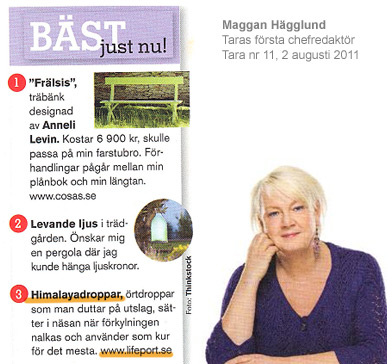
Challe Lundholm, chefredaktör Tidningen Topphälsa
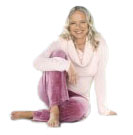
"…När det drar ihop sig till förkylningstider kommer det stora artilleriet fram hemma hos mig. Så fort jag känner minsta tendens till att de äckliga små krypen har börjat sin framfart i min kropp sätter jag hårt mot hårt. Då tar jag två magnecyl, dricker en brygd av himalyadropparna Sancho och vatten, tar några droppar i näsan också, sköljer munnen med bakteridödande medel. Och ha,ha – hasta la vista bacelusk – förkylningen drar sin kos med svansen mellan benen..."
Challes bacilldödarkit
1. Några droppar Sancho
2. Två Magnecyl, precis när du känner att sjukligheten är på väg. (Apoteket)
3. Listerine, ge de typerna en bakteriedödande sköljning som heter duga. (Apoteket)
Mr Pradip Maharjan, Entrepreneur in Nepal
In Nepal we use Sancho in many ways to improve our health. "Sancho is a unique blend of pure natural Himalayan essential oils, safe for health. In my family we use it against cold, cough, sore throat, stuffy nose, fatigue, stomachache, headache, bad breath and itching. If we go up in the hills we make sure to bring Sancho with us.
Agneta Gynning, redaktör och konstnär
Jag har provat Sancho vid ett flertal tillfällen med utmärkt resultat men jag minns speciellt julen 2004 när jag skulle åka till Vietnam och alla i min omgivning hade drabbats av förkylningar och influensa. Även jag började känna mig lite krasslig i halsen och var övertygad om att jag skulle bli sjuk och det sista jag ville var att bli kvar hemma i kalla Sverige. Jag bor på Österlen och det var en söndagseftermiddag och allt var stängt men jag visste att en kollega hade Sancho hemma så jag ringde och frågade om jag kunde komma och hämta. Jag tog min första dos på söndagskvällen. Jag blev inte sjuk och fick en härlig semester i Vietnam. Sancho finns numera i mitt husapotek! Som bonus tog det udden av mitt munsår också!
Alana Woods, USA:
Recently I was in Southern India, outside Chennai, where I took a 21-day course at the Oneness University. I arrived from the US with a miserable congestion in my throat, soreness and a cough in the mornings. This had been chronic for almost a year and nothing seemed to help. I happened to meet a wonderful healer from Sweden who gave me a little remedy called 'SANCHO" ("Feeling Good-Better"). I put 5-6 drops in a glass of hot water and drank it in the mornings. The congestion started to dissolve immediately. He had been requested to bring some bottles of it to India and gave them as gifts to the Avatars Sri Bhagavan and Amma and the monks there.
Lola Boman
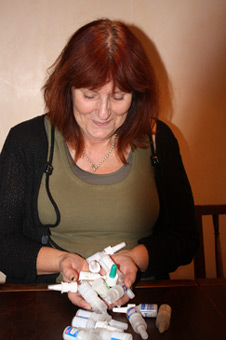
"Jag behöver inte nezeril längre tack vare Sancho dropparna som räddade mig ifrån mitt nezerilberoende!!!" - Hälsar Lola Boman
Tina
 Hej Gabor! Tusen tack för dina droppar....
Hej Gabor! Tusen tack för dina droppar....
Nu ska du få en solskenshistoria av mig. Som aktiv föreläsare måste jag alltid vara på språng och orka det där lite extra. I alla fall ve o fasa jag blev sjuk mot alla odds nedbäddad en vecka. Radio Örebro ringer, vill snabbt ha mig i studion i direktsändning. Jag ska göra en Tarotanalys om den nya lilla prinsessan...
Vad gör jag, jo halleluja! Sancho droppar knockar slemhostan. Beger mig med dropparna till studion och gör självklart succé....
Måste bara beställa en låda, nu vill andra också ha...
Kram till ER alla!
Varma hälsningar från Tina Rose, Andlig Livsinspiratör
Urban Ståhl, affärsutvecklare
Min blivande fru hade varit krasslig och förkyld under en längre tid, ett par månader, och bacillerna och virusarna ville inte släppa greppet om hennes kropp. När jag så fick höra talas om Sancho blev jag nyfiken. Jag fick en flaska på fredagen och ombads sedan att höra av mig efter helgen och berätta hur hon mådde. Efter helgen jublade både jag och min blivande fru! Hon var fri från sina förkylningssymtom. Vilken härlig känsla! Sancho ingår numera i vårt husapotek.
Anders Lindfors, egenföretagare
Jag hade en envis förkylning som direkt gav med sig när jag använda Sancho. Det var helt fantastiskt! När jag har lite tuffare perioder och jag behöver lite extra energi så tar jag även Sancho i samband med frukosten — varefter jag känner mig lite piggare och starkare. Jag kan varmt rekommendera Sancho.
Cynthia Nieb, USA
My experience with Sancho was immediate. I have very intense allergies that cause me to be foggy-headed and extremely tired most of the time. After my dose of Sancho, my head cleared, and I experienced a calm energy for approximately 24 hours. Nothing has helped me this quickly or thoroughly. Thank you for bringing this product to the United States!
Så kom Sancho till Sverige
Sancho är nyheten i väst från Himalayas sluttningar i Nepal som knockar din förkylning.
Snuva, täppt näsa, halsont och hosta etc. är några av de förkylningssymtom som lindras när du använder Sancho! Dessutom försvinner förkylningen snabbare om den alls bryter ut!
Jag upptäckte Sancho när jag och min käresta vandrade i Nepal för några år sedan. Vi hade varit ute och vandrat i bergen, Himalaya, i någon veckas tid och hade bl. a. varit uppe på Mount Everest base camp (ca 5350 m). På morgonen dagen efter och på väg nedåt vaknade vi båda med en riktigt tuff förkylning. En förkylning på hög höjd känns också alltid jobbigare.
På eftermiddagen, vid fyratiden, efter en hel dags tuff vandring, kom vi så till en bondgård där vi skulle slå läger för natten. Vi var båda väldigt trötta och slitna som man för det mesta är de första dagarna av en förkylning. En bondmora såg hur illa däran vi var och pratade med vår guide och bad honom att fråga oss om vi ville ha ett örtextrakt som skulle göra förkylningen bättre. Föga kunde vi ana hur potent denna lilla flaskas innehåll var.
Öppen för nyheter och alternativa behandlingar som jag är tackade jag bondmoran med öppen famn och bad om att få ta del av dropparna. Min käresta var inte alls intresserad av att ta droppar ur en liten flaska, som i hennes ögon kunde innehålla det mesta som är farligt och som skulle få förkylningen att framstå som något riktigt trevligt… Mellan klockan 16.30 och 21 tog jag tre doser Sancho i glas med varmt vatten. Nästa morgon vaknade jag och var nästan helt frisk. Dagen därpå var jag helt återställd till min kärestas lilla förtret. Hon var lika dålig som dagen innan och blev inte bättre trots att vi vandrade mot lägre altitud.
Ett par dagar senare fick vi uppsöka läkare då hon inte blev bättre. Av läkaren fick hon då stora röda kapslar som innehöll antibiotika mot bihåleinflammation.
Jag fick aldrig köpa flaskan av bondmoran, som jag ännu idag inte vet namnet på, hon ville inte ha betalt. När jag frågade hur jag skulle kunna tacka henne så bad hon mig att ta denna blandning till mitt land och importera det och därmed skulle Nepal, hennes land, få pengar till skola och sjukvård. Så ville hon att jag skulle tacka henne och det är också därför som du läser denna text. Sancho framställs och tillverkas i Nepal av lokala arbetare och av lokala råvaror från Himalayas sluttningar.
För varje såld flaska lämnas ett bidrag om 5 kronor till välgörenhet i Nepal som ett tack till bondmoran för att hon visade mig flaskan och för att hjälpa skola och vård för barn i Nepal.
Sancho-fonden: Välgörenhet i Nepal
Du bidrar till välgörenhet i Nepal!
För varje sålt paket går 5 kronor oavkortat till barnen i Nepal. Pengarna går till skolor och medicinsk behandling till behövande barn. Läs mer om dem som har blivit hjälpta av Sancho-fonden under Välgörenhet. Mer bilder och filmer om LifePorts välgörenhet finns på en egen sida om projektet CreatingSMILES.
Frågor och svar
Är det sant att 5 kronor går till välgörenhet i Nepal?
Ja det är sant! Detta är Lifeports sätt att tacka bondmoran i Nepal som gav Sancho till mig när jag var förkyld utan att ta betalt och alla andra som har hjälpt till och gjort det möjligt att sprida Sancho till västvärlden. Läs mer om dem som har blivit hjälpta av Sancho-fonden under Välgörenhet.
Kan Sancho verkligen hjälpa mot allt som det används för?
Folket som bor utmed Himalayas sluttningar är övertygade om att det hjälper och att det har hjälpt dem i många generationer. Nu finns möjligheten för dig också att prova och själv bilda dig en uppfattning om produkten.
Är det farligt att använda Sancho?
Sancho är en ren naturprodukt och har genomgott produktkontrollstester och godkänts av Hälsokostrådet i Sverige. Om du följer rekommendationerna på förpackningen är det inte någon fara. Om du är osäker så hör med din läkare.
Botar den allergier?
Sancho botar inte din allergi men den kan lindra dina symptom som tex täppt näsa, Prova själv och se om det hjälper just dig.
Ja du kan bli återförsäljare. Kontakta oss så hjälper vi dig att komma igång.



